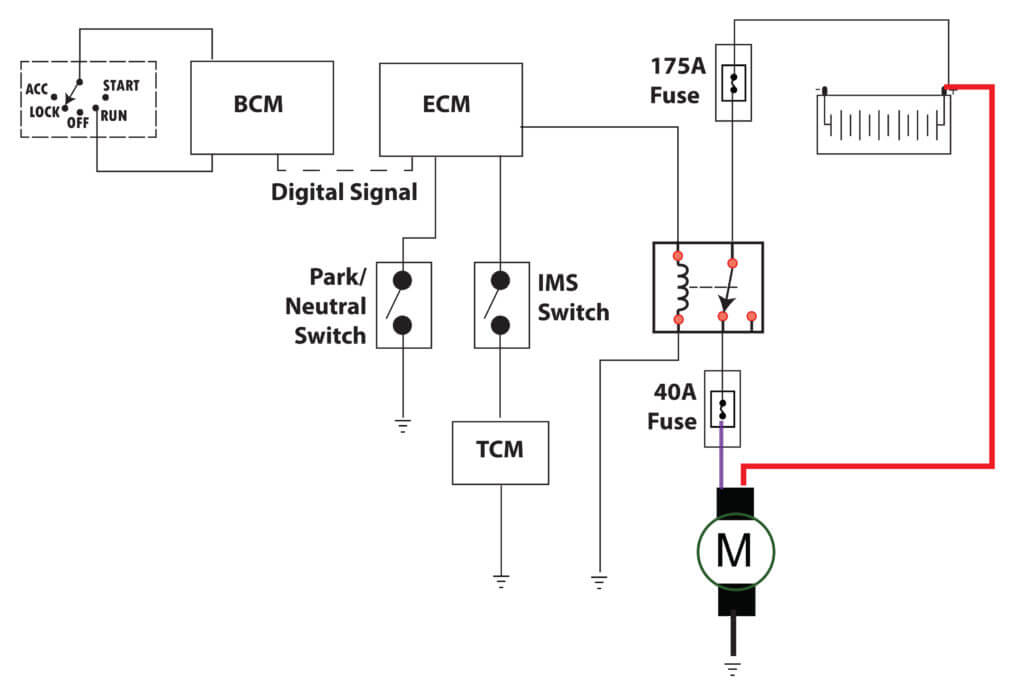Silverado intermittent no crank
Diagnose and fix a Silverado intermittent no crank condition
I’ll be honest with you, finding the cause of a Silverado intermittent no crank condition is no fun. It’s a complicate these that involves multiple switches and three computers. All the signals have to line up before the Electronic Control Module (ECM) will ground the starter relay.
Understand how the Silverado starter works
In order to diagnose a Silverdao intermittent no crank condition, you must understand how the starting system works. When you turn the key, the IGN switch acts as a signaling device. It receives a 5-volt reference signal from the body control module (BCM). When you turn the key to the START position, the IGN switch contacts close and the BCM seen the 5 volt signal as a START REQUEST.
The BCM checks the Immobilizer system to make sure you’re using an authorized key. If so, it sends a digital start request signal to the ECM.
Next, the ECM checks the park/neutral switch to make sure the transmission is in either Park or Neutral. Voltage flows from the ECM to the P/N switch and then to ground, so the ECM is looking for a voltage drop on the P/N circuit.
Then, the ECM checks for a park or neutral condition on the Internal Mode Switch (IMS) located inside the transmission. The ECM supplies voltage to the IMS. If the IMS contacts are closed, indicating either park or neutral, the voltage then flows to the Transmission Control Module (TCM) and then to a ground point. If the ECM sees the proper voltage drop it will allow engine cranking.
How power gets to the Silverado starter
Battery power runs from the battery to the B terminal on the starter motor. Battery voltage also runs through the 175 amp fuse to the starter relay terminal #30 in the underhood fuse box. Terminal #30 is the input power to one relay contact. When the ECM wants to initiate Silverado starter crank operation, it supplies power to the starter relay control coil in the underhood fuse box on terminal #86. The starter relay control coil is connected to ground at G102, G103 or G107 depending on which engine is in the vehicle.
As soon as the starter relay control coil is energized, the starter relay contacts close, sending power to fuse 62 or 57 and then to the starter on the purple wire.
Diagnose a Silverado intermittent no crank condition
Start by checking fuses 57 or 62 in the underhood fuse box. If they test good, check for battery voltage at the B and A terminals on the starter while the IGN switch is in the START position. If you see battery voltage on both terminals, test the starter motor for intermittent operation.
If you don’t see battery voltage on the purple wire A terminal on the starter, use a scan tool or DVOM and wiring diagram and check for IGN switch contact closure at the IGN terminal on the BCM. Next, check for voltage in on the park/neutral switch and ground out. Then check for voltage in and ground out on the IMS switch. Finally, check for voltage in and ground out at the TCM.
Silverado starter wiring diagram

Silverado Wiring Diagram
Causes of a Silverado intermittent no crank
Blown 57 or 62 fuse in underhood fuse box
Chaffed wire to P/N switch
Chaffed wire to IMS
Chaffed wire to TCM
Bad ground connection from park/neutral switch
Bad ground connection from IMS
Bad ground connection from TCM
Bad P/N switch
Bad IMS switch
Bad starter relay (swap with another rely in the underhood fuse box.
Chaffed purple wire from
©, 2018 Rick Muscoplat
Posted on by Rick Muscoplat